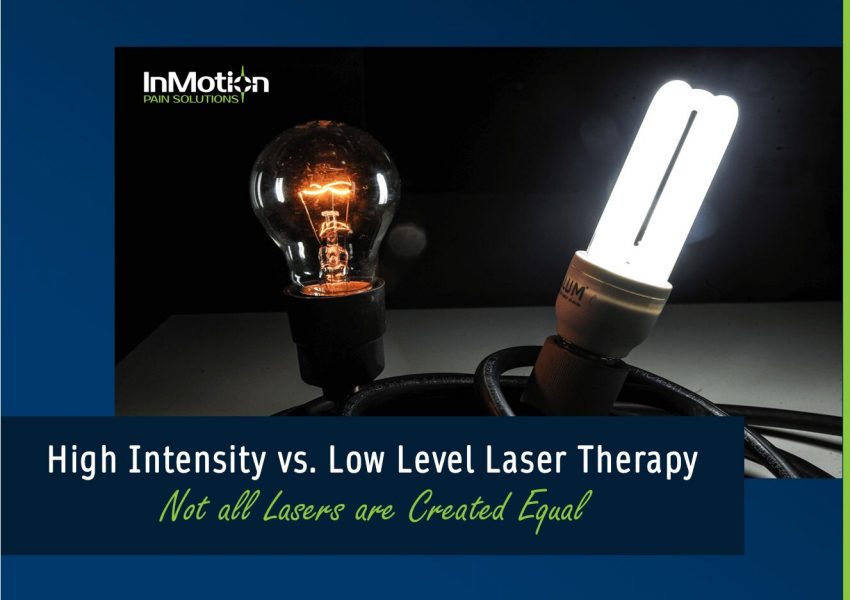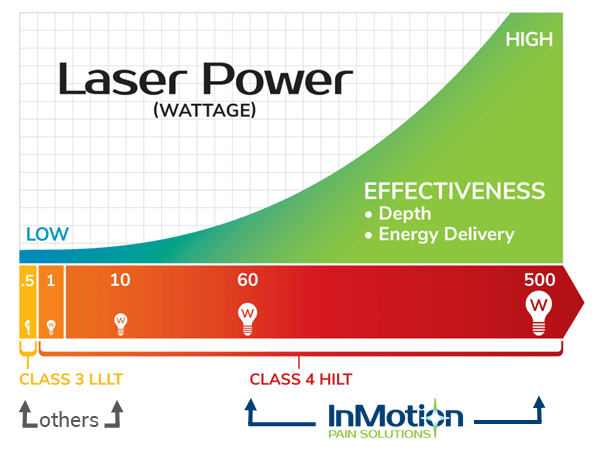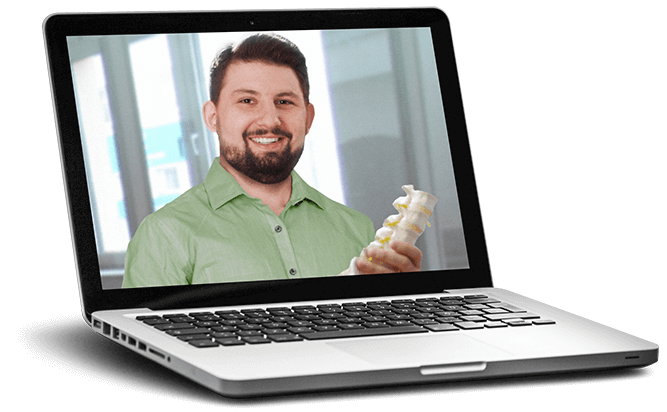High Intensity Laser Therapy vs Low Level Laser Therapy

As the availability of laser therapy grows in the United States, it is important to know that not all lasers are created equal. Healing lasers utilized in practice have a wide range of specifications which impact how effective the laser is at treating chronic pain. This article will outline the key differences between High Intensity Laser Therapy and Low Level Laser Therapy so that you can have an informed conversation with your doctor about which is best for your chronic pain.
Classifications of Lasers Used in Therapy and Recovery
The FDA uses four classifications for lasers, including therapeutic lasers, based on their wattage and potential to cause injury if used improperly.
Class 1 lasers are those that are less than 0.39 milliwatts (mW) in power. These are the types of lasers used in laser printers and DVD players.
Class 2 lasers are those emitting less than 1 mW. These are the types of lasers used in bar code scanners and some laser pointers.
When it comes to therapeutic lasers for pain, we need to move into Class 3 and Class 4 lasers.
Class 3 lasers emit between 1 and 500 mW (or 0.001 – 0.5 watts). This classification has a broader range of power and includes everything from the lasers used in laser light shows to Low Level Laser Therapy (LLLT) devices used to treat pain.
Class 4 – Any therapeutic laser with a wattage greater than 500 mW (0.5 watts) is considered a Class 4 laser. This class is the broadest range, including medical grade lasers used for therapy and surgery as well as industrial lasers. Therapeutic lasers for chronic pain treatment, known as High Intensity Lasers or High Powered Lasers, fall into this class. The therapeutic lasers for pain most commonly seen in clinical practice are 10 watts or less. This is due to their relative affordability. At InMotion Pain Solutions, we utilize both a 60-watt and 500-watt laser which have a broad range of therapeutic applications for pain relief and injury recovery.

Therapeutic Laser Variables
There are several terms to know when looking at different therapeutic lasers and how effective they are at treating your pain.
Wattage. Wattage refers to the power emitted by the laser. One watt (W) is equal to 1000 milliwatts (mW). Watts and milliwatts are both commonly used to describe the power of a therapeutic laser.
If you think about the common light bulb, you know that a low-wattage bulb gives off less light than a high-wattage bulb. Depending on where you are using the light, you will choose the wattage, or power, that works best in that situation. The same is true for therapeutic lasers.
Wavelength. Light is emitted in the form of waves, with peaks and valleys. The distance between two peaks is known as the wavelength, and the unit of measurement of a laser wavelength is nanometers (nm). Wavelength is important because it determines how much of the light is able to penetrate beneath the surface of the skin. Higher nanometers means a higher the percentage of laser light is able to reach the damaged tissue. Lasers that operate at lower nanometer levels are best for surface wounds and skin disorders. Therapeutic lasers that operate at higher wavelengths are better able to treat injuries to deep soft tissues (e.g. muscle, joints, ligaments, etc.).
Continuous, Pulsed, Super Pulsed. Healing laser light is delivered either in a continuous, pulsed, or super pulsed manner. If you think of a flashlight, a continuous wave would be the light being switched to “on”. A pulsed wave can be compared to turning the light off and on in a repetitive fashion. When it comes to pulsing therapeutic lasers, the pulsing is done so quickly and at such a high frequency it is not visible to the naked eye.
The benefit to pulsing laser light is that the time during which the light is switched off allows both the laser and the treatment area to cool. In super pulsed lasers, very high levels of light energy are delivered in factions of a second. This enables the laser to deliver more energy deeper into the tissues without causing the tissues to overheat. This is just one of the many safety features incorporated into High Intensity Laser Therapy. As a comparison, the energy from a 905 nm continuous wave laser penetrates to approximately 2.5 cm. However, a 905 nm super-pulsed laser can deliver energy to a depth of 10 cm1.
Some lasers operate in a dual-channel mode that benefits both superficial and deep tissue.
Dosage. The amount of energy or dosage that is delivered to a unit of area of the body is measured in joules. Joules is calculated by multiplying watts by time in seconds: Joules = Watts (Seconds). The unit measurement is Joules/cm2. High Intensity Lasers are able to deliver more joules to the body in less time than Low Level Lasers.
Compare Pain Treatments
Medications? Injections? Surgery? InMotion Treatment?
Which is the best choice for you?
Get our side-by-side comparison to help you decide.
HILT Delivers More Healing Energy to Deeper Tissues in Less Time
In order for the laser to do its job, it must reach the tissue at the depth at which it is injured. Power, wavelength, delivery mode, and time combine to make this happen. The treating physician will determine the parameters for each patient depending on the condition for which he or she is being treated. This will ensure that the proper amount of light energy is getting to the damaged tissues in order for the patient to benefit from the healing power of laser therapy.

Low Level Laser Therapy, or Cold Laser Therapy, requires significantly more time to deliver the same amount of energy to tissues than High Intensity Lasers Therapy. It is also important to realize that Low Level Lasers are not able to penetrate as deeply as the more powerful High Intensity Lasers. High Intensity Lasers are also able to treat a wider area than Low Level Lasers. This enables the healing light energy to be delivered not only to the injured area, but to the supporting tissues that surround the injury.
Which is Better – High Intensity Laser Therapy or Low Level Laser Therapy?
That depends. Just like a 40-watt light bulb might be perfect for an accent lamp in your living room, it is not powerful enough to light up your garage. The same is true for laser therapy – you need to choose the therapy that will work best for your condition.
For new injuries or those closer to the surface of the skin, LLLT can provide pain relief and recovery benefits. But for chronic pain and injuries that are deep within joints, HILT is the better choice because it enables the healing light energy to reach the tissue at the depth it is injured.
It is important to remember that there is a wide range of wattages, or power, within the Class 4 laser classification. The most common High Intensity Lasers used in clinical practice are those that are 10 watts or less. This is because they are the most affordable High Powered Lasers on the market.
InMotion Pain Solutions has its roots in treating professional football players in Green Bay, Wisconsin as well as Olympic athletes. When it was discovered that Cold Laser Therapy was not strong enough to treat these athletes, High Intensity Lasers were brought in. Even then, 10-watt lasers were not strong enough to penetrate deep into injured joints.
It was at that point that the 60-watt and 500-watt lasers that we use at InMotion Pain Solutions’ laser clinic were developed. These lasers have been remarkably effective in treating both injured athletes and those in chronic pain. Our lasers are among the most powerful available anywhere in the world. This technology, combined with our exclusive treatment protocols, is not available anywhere else in Eastern Iowa. Now, anyone has access to the conservative pain solutions once reserved solely for elite athletes.

WATCH OUR
Free Online Webinar
- Understand Why Your Are in Pain
- Learn Why Other Treatments Haven’t Worked
- Discover Our New Approach to Pain Relief
No-Cost Consultations and Second Opinions
If you are suffering in chronic pain, or considering joint or back surgery, you owe it to yourself to see if the FDA-cleared, non-invasive treatment options at InMotion Pain Solutions may benefit you. Schedule a no-cost consultation with Dr. Ben Wyant to discuss your condition and ask any questions you might have. These appointments at our Cedar Rapids, Iowa clinic are no-risk and no-obligation to you. You can reach us by calling 319-200-1495 or filling out or contact form.
Learn More:
Dr. Ben Wyant, D.C.
If this information was helpful, share it!
SOURCES:
- Gross AR, Dziengo S, Boers O, et al. Low Level Laser Therapy (LLLT) for Neck Pain: A Systematic Review and Meta-Regression. Open Orthop J. 2013;7:396-419. Published 2013 Sep 20. doi:10.2174/1874325001307010396. Retrieved from: https://pubmed.ncbi.nlm.nih.gov/24155802/
- Light Bulb Photo Credit: By Marcello Casal Jr/Agência Brasil – http://agenciabrasil.ebc.com.br/economia/foto/2015-07/lampadas-incandescentes-serao-retiradas-do-mercado-ate-2016, CC BY 3.0 br, https://commons.wikimedia.org/w/index.php?curid=41348496



